Meadowbank has always been special to me, as the majority of my early days learning flyfishing were spent here.
I relish my time at Lake Meadowbank, not only because of the great fishing it offers but also for the very pleasant surrounds. Although the southern portion of the lake below Dunrobin Bridge does have some good fishing, it’s the northern basin that is of the most interest and indeed holds the best trout, so this is where we will concentrate for this article.
The turn off to Dunrobin Bridge, which leads to the most convenient access to the northern basin is situated around half way between the two southern midland towns of Hamilton and Ouse. There is a good quality boat ramp on the western side of the bridge causeway. On the eastern side of the bridge there is a turn off which leads to a convenient camping area and an easy starting point for shore access to the western side of the northern basin.
All of the bays and channels of the western and north western shore are rimmed by tussocks and bull rushes with stands of willows. This area consists of many easily and safely wadeable flats with a few deeper entrance channels.
The series of small finger like bays and flats on the far northern shore to the left of where the Ouse River enters the lake is a very fishy area and I’ve had some fantastic fishing here, especially in Caenid hatches. You need landowner permission to access the shore here unless you arrive by boat.
Meadowbanks is open and fishes well all year round, but the best flyfishing starts in the August/September period. I learnt to fly fish here with my uncle, Ken Broadby, my grandmother and two of Ken’s fishing companions John and Colin. With only a handful of other regulars that fly fished Meadowbanks on a regular basis, we developed a range of wet flies and nymphs just for this water with the main materials being peacock herl and sword feathers. Hot orange was found to be very effective way before it became popular elsewhere in Tasmania.
Since 1995 the lake has received regular stocking with large redundant brood stock Atlantic salmon up to 7-8kg, making the lake popular with land-based lure casters and trolling anglers throughout the year. You either love or hate the policy of stocking with salmon but one thing is for certain no one ever complains when they hook one!
Rainbow fingerlings have also been stocked into the lake with ad-hoc releases through the 80’s but regular releases from the mid 90’s ensures a very good population of rainbows to 2.5kg that eagerly work the early morning windlanes as rainbow trout do.
The brown trout though are the real jewels. This is ideal water, plenty of shallow bays and flats close to deeper water and channels, extensive weed beds, heaps of structure and a plethora of trout food, aquatic and terrestrial. We have landed several browns around 2.7kg range over the years and seen and lost much larger fish, although most browns are around 1-1.5kg.
Lake Meadowbank sits at a lower elevation than highland lakes and lagoons, so the shallows are a lot warmer and aquatic life is very active from late winter onwards. The fish patrol around the bull rushes, reeds and tussocks hunting out stick caddis and snails. If the levels are high and the water has flooded past the margins we can add corbie grubs worms and spiders to the menu. Into spring spawning frogs also make an appearance.
Searching around the margins with a Mk2 Woolly Bugger, orange bodied Mrs Simpson or an Orange Ken’s Killer is a great way to interest a fish. If you ever happen to visit when the lake is low with a grassy verge showing below the tussock line you just could be in for some fantastic fishing to fish tailing and bow waving all over the place!
As the water level recedes all the aquatic life that stays hidden in and around the tussock, rushes and other foliage lined edges at normal levels suddenly has no choice but to follow the water out causing a smorgasbord of food available for the browns. Believe me when I say the fish can tail furiously when this happens. My brother and Uncle struck these conditions late one spring, with trout bow waving all over the place in the extreme shallows. They couldn’t work out what the fish were chasing until they landed a couple of very good fish approaching 2kg, and found the fish contained tench fry forced out of cover due to receding water.
By mid-spring the mayfly make an appearance, although reasonable rises to duns do happen, it’s the red spinner that really gets the fish fired up. On fine sunny days with light winds the fishing to spinners can be spectacular. There are always the smaller leapers present but plenty of the bigger mature fish are also patrolling clipping down the spinners.
Even if a bit of a breeze does get up there are plenty of sheltered areas to still find spinners over the water, around the ‘Point’ there is a series of channels that create islands sheltered from the breeze, and this is a great place to find fish on the spinners. The steeper eastern shore, north of the boat ramp is a great spot in an easterly, with fish patrolling the willows and the steep banks, you do need to fish from a boat here though. A parachute spinner pattern is the go, the Bruce Gibson tie is very effective, and we have also used a Peacock and Claret nymph, to great effect on the red spinner feeders.
Midging fish in the windlanes are a real feature. Regular windlanes and slicks form immediately north of the bridge, reaching to and just around the point. At times the chironomids (midges) in the windlanes are so thick that they turn the slicks into a yellowy/green shade.
In the early years we developed a fly called the Peacock Nymph, all it really is, is a simplified version of the North American pattern called the Zug Bug. It consists entirely of peacock herl and a tail of peacock sword feather. We fished this fly in the low light of early morning on a long fine leader with a 2kg tippet, casting well in front of the midging fish drawing the fly across the trout’s bow or directly away from it. Some of the takes can be jarring but often just a slow steady increasing weight on the line.
We have found the Peacock Nymph very effective in many situations, fished static to tailers or to nymphing fish, and it’s also very effective fished upstream in rivers.
As the light increases as the morning progresses, a small Iron Blue Dun did and still does take many windlane feeders. Although browns were the majority in my earlier windlane fishing at Meadowbank, it’s the rainbows that rule Meadowbank’s lanes and slicks these days, most fish are around the 500g-1.5kg but there are some real surprises.
Depending on which end of Tasmania you come from dictates how you pronounce the name of my favourite mayfly! In the south most pronounce it kaynid; in the north they are correctly pronounced seenid. However you pronounce it, the fact is the caenid hatches in Meadowbanks are massive, as big, if not larger than any caenid hatch on any water in the state.
Caenis mayfly are the smallest of Tasmania’s mayfly species occurring on both moving and still waters, although trout do occasionally feed on the emerging nymphs it is the spent spinners that attract the most attention, as the imago’s hatch very fast and fly off, often hatching into spinners all over the boat or your person.
Spinners fall in huge numbers with the fish taking with a rise form called ‘smutting’, taking 3-5 naturals in quick succession with the top half of their heads out of the water making a ‘clip’ sound as they take a natural, then often changing direction which can be very frustrating. The trick is to present your fly where you anticipate the next take to be, this calls for accurate casting!
The hatches usually get going by the second week of November and then tapering off after the end of January. A forecast of a warm day with light variable winds is tops, if the morning is overcast, that is a real bonus, a dull morning will greatly extend the fishing time, especially for anglers without the benefit of a boat, the fish will still ‘smut’ in the brighter conditions in deeper water but they are extremely hard and mostly out of reach when wading.
The spinners usually fall around or slightly after sunrise and the fishing is usually over by about 11am. I’ve been on the water before light and heard trout smutting before it has been light enough to see them, on other occasions the fishing has been extended greatly. One day I was surprised to get back to the boat ramp after the fish had finally stopped working to find the time was 3pm, no wonder I felt like a spent spinner!
We have always used a #14 or #16 Iron Blue Dun dry for caenid feeders, of course other patterns will work but I have complete confidence in the Iron Blue. Unfortunately Meadowbanks is infested with stunted redfin perch and they love feeding on caenid as much as the trout do. They will fool you into thinking they are trout, especially when the trout are sipping naturals more than actually smutting on them as they often do. After a while you will learn to tell the difference.
A gentle southerly or easterly breeze can be a real bonus as the morning advances. The breeze will push the caenid into the bays and around the rushes and reeds, making for some fascinating fishing as the fish work the Caenid in beats. At other times the fishing can be very quiet in close and the only option is to reach the fish by boat. This is where you need to fish a longer and very accurate cast.
Meadowbank has a great variety of fishing with some fabulous browns and rainbows waiting to be caught in a very pretty setting. It is a wonderful fishery quite close to Hobart and within easy striking range of the highlands should that dreaded summer cold front blow you inside out.
Reads: 6860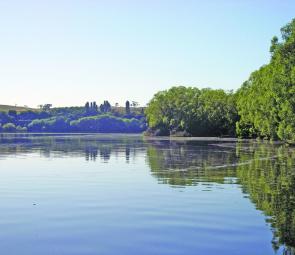
A slick of chironomids, like a big bowl of soup for trout.
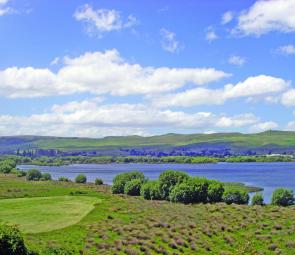
Some of the shore and bays of the northern basin.
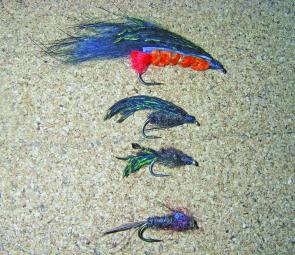
Effective Lake Meadowbanks wets, from top to bottom, Ken’s Killer, Damsel Peacock Nymph and the Peacock and Claret Nymph.
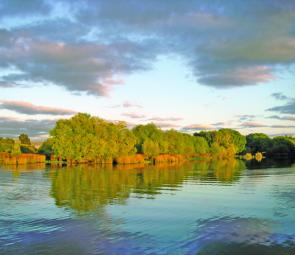
It’s a pretty lake.

A typical Meadowbanks brownie, well conditioned and great markings.
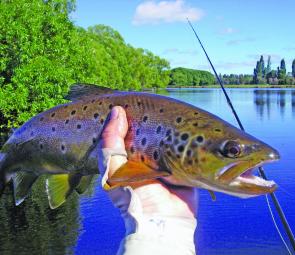
A nice fish that was sipping Caenid’s from underneath a Willow.

Fish on! A perfect caenid morning, calm, warm and cloudy. Notice the clod of Caenid Spinners in the air.




